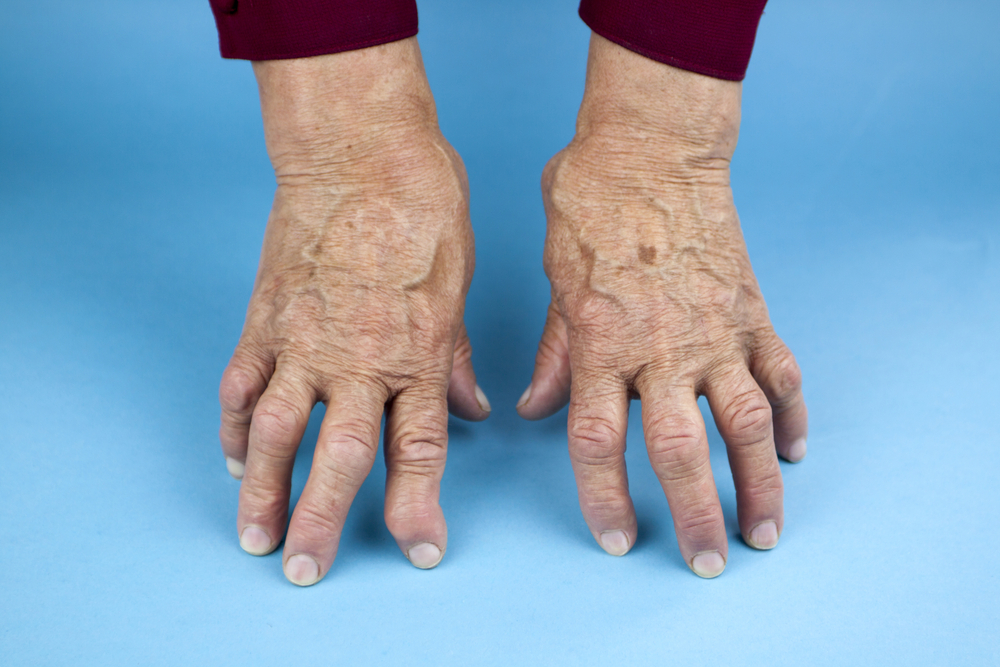What Causes Rheumatoid Arthritis (and How to Turn it Off)


The Doctor looks up from the clipboard and says, “The test results show you have Rheumatoid Arthritis…”
For some, finding out they have Rheumatoid Arthritis (RA) is a relief, finally an answer for the crippling pain.
For others, it’s a diagnosis without much hope.
RA affects roughly 1.5 million people in the United States. [1]
The disease is three times more prevalent in women than men.
For those of you who are living with RA or have a close friend or loved one affected by it you know how crippling it can be. RA, unlike osteoarthritis, is not caused by wear and tear – it’s actually a little more tricky, it’s an autoimmune disorder. Your body actually begins to attack your joints.
Normally, the immune system that’s supposed to protect you from foreign invaders, turns inward and attacks your own tissues and becomes an autoimmune issue…
My Immune System Attacks My Joints?
Yes, your immune system is waging war on your joints. But it’s a bit more complicated than that.
Joints are where two or more bones come together. There are several different types of joints but the ones affected by RA, the ones we will be talking about here, are Synovial Joints.
These are joints of the fingers, wrists, hips, knees, ankles and feet that RA can affect. Unlike regular osteoarthritis, RA generally affects pairs of joints. So if you have RA in your left knee, it’s going to be in your right knee too. If you have RA in your right big toe it’s going to be in your left big toe as well.
These types of joints are lined with this amazing stuff called synovial tissue. The synovial tissue forms a membrane and secretes this stuff called synovial fluid. This fluid is super important for healthy joints. It has three main functions:
- Lubricates the joint
- Nourishes the cartilage
- Absorbs shock from impact
Every time you move, you flex your knee to squat at the gym, tap your fingers to type, stand on your tippy toes and extended your shoulder to reach the top shelf, your joints have to articulate. They have to slide over each other to allow for movement. Take a door hinge for example: the hinge allows the door to swing open and shut, just like the joints in your body. If the hinge gets sticky you may put a little oil in it, something to lubricate its movement. That’s one of the things synovial fluid does for joints.
But it’s not just a lubricant…
It actually nourishes them.
The fluid carries nutrients to the cartilage on the surface of your joints. Cartilage is smooth silky tissue on the articulating portions of joints, the portions where they interact. So, in your knee the bottom of your femur and the top of your tibia have cartilage on their surfaces. Cartilage also plays a huge roll in pain-free, fluid movement (anyone who has been told they’ve worn the cartilage out of a joint definitely knows this). But it’s fed by nutrients in the synovial fluid.
Finally this fluid helps with impact.
Think about bubble wrap: those air-filled pockets that are used to ship fragile things. When you try to squeeze those air-filled pockets of bubbles it’s really hard to get them to smoosh together… and that’s much like your joint. Every time you smoosh a joint (they call it compressing a joint) the synovial fluid provides that cushioning and helps to distribute impact.
So this synovial stuff is pretty cool and pretty important.
But When You Have RA, Your Immune System Attacks the Synovial Tissue in Your Joints
Your immune system is an army with an innate ability to adapt and protect you from an outstanding number of possible infectious agents.
There are specialized cells that can not only take down foreign pathogens but remember them for future exposures. They can clean up cuts, repair broken tissues, kill selected targets, and communicate harmoniously while doing it.
When this normal, healthy, life saving process gets turned around on your own tissues it can cause serious problems we classify as autoimmune disorders.
RA is just one of many, many autoimmune disorders.
With RA, the tissue under attack is synovial tissue of your joints and this tissue becomes inflamed and angry. The synovial tissue starts to thicken in response and secretes more synovial fluid, which causes the joints to swell.
The inflammation and swelling causes pain and stiffness associated with the disease.
When this occurs it’s considered a “flare up.”
Some people are only affected by RA for months or a couple years while others battle with decades or lifetimes of flare ups. Long-term RA can cause joint damage and this is where it gets a little scary.
After years of battling with your body, the joint tissue begins to break down. The cartilage wears away, making joints extremely sensitive, and can eventually lead to the immune system attacking the bony surface of joints themselves. A joint with no cartilage is like having a rusty door hinge. The lubrication has dried up, the paint has peeled off, the metal is rusting, and the swing is no longer smooth.
Furthermore, RA can begin to affect other bodily systems like the skin, heart, and lungs. And according to The Arthritis Foundation, the goal of someone suffering from RA is to get the disease into remission…. of which the current standard treatment for RA consists of:
- Drugs
- Surgery
- Alternative therapies
But What Really Causes Rheumatoid Arthritis?
The cause of RA is not fully understood.
But current research is finding ties to the gut, hormones, genetics, and environmental and dietary factors. Current research shows genes as the largest player in deciding who gets RA and who doesn’t, but gut flora, hormones, environmental and dietary factors are thought to “trigger” these genes.
Once triggered, an inflammatory/immune response is initiated. The development of RA is thought to occur in stages. Once the immune response gets triggered, it’s a slow build. You may carry autoantibodies and inflammatory markers but show no symptoms. Eventually, this leads to IA (Inflammatory Arthritis) and finally progresses to Rheumatoid Arthritis. The idea behind this is that something, whether you are genetically predisposed or not, triggers that immune system to start attacking the synovial tissue of joints.
Some interesting research points to the role of gut health in all of this. Take the following studies…
1) Dr. Dan Littman ran stool tests on 114 healthy individuals and those with RA or psoriatic arthritis. The stool test results pointed to the bacterium Prevotella corpi, which was found in the stool of 75% of people with new-onset, untreated RA. However, only 12% of people with treated rheumatoid arthritis had it. It was present in 38% of the people with psoriatic arthritis, and finally 21% of the control group (the healthy people). What does this mean? Higher numbers of P.corpi were associated with lower numbers of beneficial bacteria… and more prevalence of untreated RA.
2) Another study looked at the effects of microbes in mouse models. These researchers introduced segmented filamentous bacteria into germ-free mice and found that Th cells (part of your immune system) and autoantibodies were produced and followed by a rapid onset of arthritis. The researchers concluded that a single commensal microbe (a microbe that benefits from living in us, but shouldn’t affect us) can trigger immune system response (in this case a specific subset of Th cells the Th17 cells) and allow for the development of an autoimmune disease. Th cells and specifically Th17 cells help us fight infection and are starting to be linked more closely with the development of autoimmune disorders.
3) It doesn’t stop there. Researchers have also identified genes that are associated with a greater susceptibility to developing RA in mice. The gene is HLA-DRB1*0401, which doesn’t mean much to us regular people… until you take a deeper look and see that these researches are looking at HOW that gene affects the gut flora in mice and how THAT can then affect an increase in cytokine production and immune response, possibly leading to autoimmune disorders. They say that mice with the 0401 gene have a greater disposition toward gut flora imbalances. So, because of genes, these mice may have more bad bacteria than good. This stuff is wild.
So let’s take a step back out of the research and ask what does this mean? This research supports the notion that gut flora and autoimmune disorders are linked. In some of the studies above, it was mentioned that your gut flora is affected by your genes as well as your environment. And if you’re anything like me, you might be wondering…
Is Rheumatoid Arthritis reversible?
Until Recently, We Thought Autoimmune Disease Wasn’t Reversible
We’re just beginning to understand why the immune system would attack healthy tissue… and in the beginning, we used to think that autoimmune diseases couldn’t be reversed once the immune condition “turned on.”
However, the latest evolution in autoimmune research indicates there might be another way…
Researcher Alessio Fasano, M.D. has been on the forefront of recent autoimmune and Celiac Disease research. In 2011, he published a paper titled “Leaky Gut and Autoimmune Diseases” introducing a new theory that suggests prevention and reversal of autoimmune disease is possible.
He presents the idea that three pre-existing conditions must all exist together in order for autoimmune diseases to develop. [2] They are:
- A genetic predisposition to autoimmunity (In the case of Celiac Disease that’s the HLA DQ2/DQ8 genes)
- An exposure to the environmental trigger (in Celiac Disease – that’s gluten)
- Increased Intestinal Permeability (Leaky Gut)
Fasano’s theory is part of the new evolution of research implicating leaky gut as the key element to the development of autoimmune diseases like RA… and also begins to open the idea that we might be able to ACTUALLY turn off the autoimmune response in the body if we start with the gut.
How to Turn Off Your Autoimmune Disease
If you’re struggling with autoimmune diseases like RA, you know how crippling it can be when your body attacks itself. Struggling with this type of diagnosis can lead to serious depression… I know, because I’ve been there too.
But what if there was a way to begin to turn off the autoimmune response?
What if there was a way to calm down your immune system and allow it to begin to repair the damage?
Based on the work of Dr. Alessio Fasano, one of the first places to start is your gut… and we’re here to help you.
We hosted a free webinar called, “How to Turn Off Your Autoimmunity — and Restore a Healthy Immune System.”
It’s completely free, and we dove deep into your gut health and how to begin to stop the immune system from attacking itself.
You could spend years trying to figure out how to “fix” your immune system… or you could register for this free one-hour webinar and we’ll show you how we did it.
As someone who suffered with autoimmune disease for years and almost gave up hope, I know your struggle. I hope you join us for the webinar to learn more about how I turned off my autoimmune response and restored my health.
So grateful to support you in health.
-Jordan
Did You Like this Article?
Subscribe to our newsletter to receive email notifications, some ways to find relief, and next steps.
